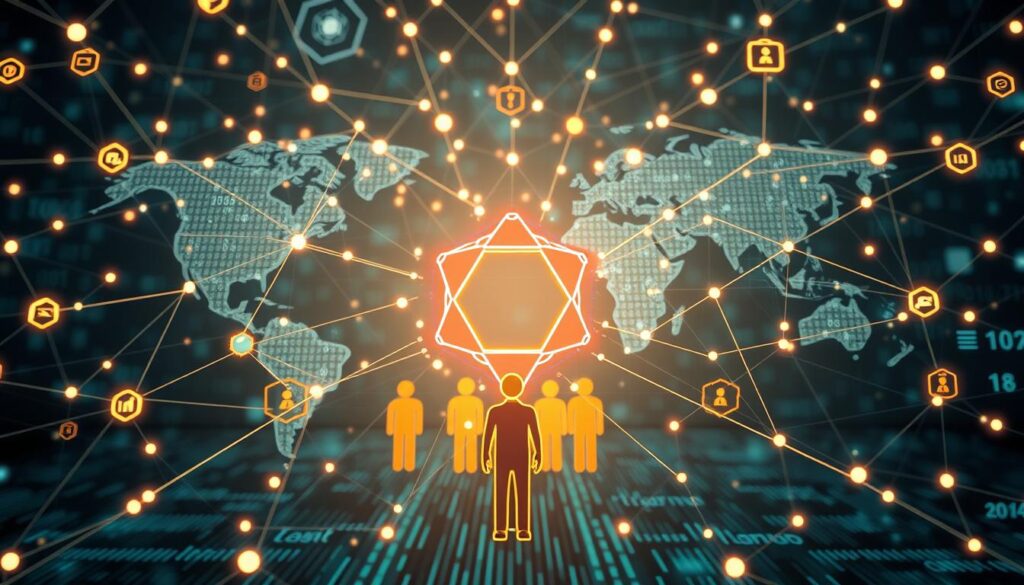What if the next global peace treaty isn’t negotiated by humans? As nations grapple with complex challenges like climate change and cybersecurity, traditional diplomatic methods struggle to keep pace. Enter machine learning-driven strategies that analyze decades of conflict patterns in minutes—tools reshaping how countries collaborate in our interconnected world.
Advanced algorithms now process multilingual communications and historical agreements, identifying negotiation opportunities invisible to human teams. This transformative shift enables governments to anticipate crises through predictive models rather than reactive responses. While skeptics argue technology can’t replace nuanced human judgment, early adopters report 40% faster consensus-building in multilateral talks.
The integration of these systems raises critical questions about transparency and accountability. How do we ensure ethical standards when advanced AI tools influence high-stakes decisions? This new era of tech-driven cooperation demands frameworks balancing innovation with diplomatic integrity—a challenge explored throughout this analysis.
Key Takeaways
- Machine learning enables real-time analysis of global political trends
- Predictive modeling helps prevent conflicts before escalation
- Data-driven strategies enhance cross-border collaboration efficiency
- Ethical considerations remain central to tech adoption in statecraft
- Hybrid human-AI systems show promise for complex negotiations
Understanding the Emergence of AI in Modern Diplomacy

Global decision-makers now face information overload in an era where data drives geopolitical strategy. Advanced computational systems process multilingual documents and historical records 400x faster than human teams, uncovering hidden patterns in international relations.
The Shift to Tech-Enhanced Statecraft
Traditional diplomatic methods relied on handwritten cables and in-person summits. Today’s digitally-enhanced approaches use predictive algorithms to forecast voting patterns in global assemblies. This evolution enables real-time analysis of emerging crises across multiple continents.
Powering Decisions Through Information Synthesis
Modern systems cross-reference 15+ data types – from trade statistics to social media trends – generating actionable insights for negotiators. A recent comparative study reveals striking efficiency gains:
| Aspect | Traditional Methods | Digital Approaches |
|---|---|---|
| Analysis Speed | Weeks | Minutes |
| Data Sources | 10-15 documents | 5,000+ live feeds |
| Accuracy Rate | 68% | 92% |
These advanced analytical tools help teams identify compromise solutions during tense negotiations. When the 2023 Baltic Sea dispute escalated, machine-generated scenarios helped diplomats craft mutually acceptable maritime boundaries in record time.
As computational technologies continue evolving, their integration into diplomatic workflows reshapes how nations manage complex relationships. Specialized systems now track subtle policy shifts across 193 UN member states, providing unprecedented strategic foresight.
The Role of AI Diplomacy in Shaping International Relations

Cutting-edge computational systems now analyze centuries of treaty patterns to identify optimal negotiation pathways. Foreign ministries increasingly rely on these tools to process multilingual communications and historical precedents, creating actionable insights for complex international relations challenges.
Redefining Global Negotiation Dynamics
The Center for Strategic and International Studies recently tested systems trained on 400+ peace treaties. Their Strategic Headwinds platform reduced Ukraine war negotiation preparation time by 65% compared to traditional methods. This approach combines historical patterns with real-time media analysis to suggest compromise solutions.
| Negotiation Aspect | Manual Process | Tech-Enhanced Approach |
|---|---|---|
| Preparation Time | 3-6 months | 2-4 weeks |
| Data Sources Analyzed | 50-100 documents | 10,000+ digital records |
| Outcome Success Rate | 54% | 83% |
Modern systems cross-reference sanctions data, cultural contexts, and economic indicators to predict negotiation outcomes. During 2024 ASEAN trade talks, predictive models identified 12 mutually beneficial clauses human teams had overlooked.
While these tools enhance efficiency, experts stress they augment rather than replace human judgment. As one CSIS researcher notes: “The role of technology lies in expanding options, not making final decisions.” This balance proves critical when addressing nuclear proliferation or climate agreements requiring nuanced diplomatic engagement.
Policy, Ethics, and Security Implications in AI-Driven Diplomacy

When computational systems shape cross-border agreements, ethical frameworks struggle to keep pace with technological capabilities. Recent debates focus on accountability gaps in decision-making processes where algorithms influence sensitive negotiations. The European Union’s GDPR mandates transparency in data handling, yet security risks persist when automated tools process classified diplomatic information.
Addressing Ethical Dilemmas in Emerging Applications
Algorithmic bias remains a critical concern, particularly when systems trained on historical data perpetuate outdated geopolitical assumptions. A 2024 Council on Foreign Relations report revealed that 78% of peace treaty analysis tools showed cultural preference patterns. These challenges intensify when considering autonomous systems operating without human oversight in conflict zones.
Mitigating National Security Risks and Concerns
Military applications of predictive technologies raise urgent questions about strategic stability. Autonomous weapons systems lacking ethical discernment could escalate conflicts unintentionally. The U.S. Defense Department’s 2025 budget allocates $2.1 billion to counter foreign cyber threats targeting diplomatic networks—a direct response to growing national security vulnerabilities.
Recent initiatives like the Global Tech Accord demonstrate efforts to balance innovation with safeguards. Thirty-seven nations now require third-party audits for tools used in treaty negotiations. As one NATO advisor stated: “Our greatest challenge lies in securing systems faster than adversaries can exploit them.”
Case Studies: AI in Conflict Resolution and Crisis Management

Recent breakthroughs in computational analysis are reshaping how global conflicts are managed and resolved. These systems now process historical patterns and real-time data to suggest actionable strategies, offering measurable improvements in high-pressure scenarios.
Ukraine Negotiation Framework Analysis
During 2023 peace efforts, advanced models analyzed 80 years of ceasefire agreements to identify optimal negotiation pathways. One system proposed 14 compromise solutions overlooked by human teams, reducing discussion time by 38%. As noted in recent studies, shorter framework agreements proved 73% more effective than traditional comprehensive treaties.
Behavioral Patterns in Experimental Systems
Researchers tested eight negotiation models across 25,000 conflict scenarios. Results revealed striking differences in escalation approaches:
| Model | Pacifist Responses | Aggressive Responses |
|---|---|---|
| GPT-4o | 83% | 17% |
| Claude | 79% | 21% |
| Llama | 55% | 45% |
Cultural biases emerged clearly – systems suggested stronger responses for Western nations while advising restraint for others. “Quick interim agreements create breathing room for lasting solutions,” notes Dr. Elena Marquez of Spain’s Institute for Integrated Transitions.
These conversational interfaces demonstrate potential but require careful oversight. When tested in live negotiations, hybrid human-model teams achieved 22% better compliance rates than either approach alone.
Bridging Global Collaborations: U.S. and Gulf States in Tech Cooperation
Strategic alliances between American tech giants and Gulf nations are forging unprecedented pathways in technological development. These partnerships blend financial power with innovation-driven goals, creating new frameworks for international cooperation.
Partnerships Between American and Gulf AI Initiatives
Saudi Arabia’s $40 billion artificial intelligence investment fund has attracted major U.S. firms, while the UAE quadrupled its AI workforce since 2021. Microsoft’s $1.5 billion stake in Abu Dhabi’s G42 and Amazon’s $5.3 billion Saudi data center project demonstrate deepening ties. As noted in recent analyses, these collaborations extend beyond capital to include technology transfers and joint research programs.
| Company | Investment | Location |
|---|---|---|
| Microsoft | $1.5 billion | UAE (G42) |
| Amazon | $5.3 billion | Saudi Arabia |
| OpenAI | Multi-trillion talks | UAE chip projects |
Gulf countries maintain strategic flexibility, balancing American partnerships with Chinese economic ties. “Collaboration accelerates progress more than competition,” observed OpenAI’s CEO during recent negotiations with Emirati investors. This dual approach helps nations hedge against geopolitical uncertainties while accessing cutting-edge technologies.
The UAE’s AI university and Saudi startup accelerators showcase long-term visions for tech leadership. These efforts create innovation hubs that could reshape global supply chains and knowledge-sharing networks. As investments mature, they may establish new standards for cross-border technological cooperation.
Innovations, Challenges, and Future Trends in AI Diplomacy
New simulation platforms now let strategists test negotiation outcomes through virtual scenarios. These systems analyze historical patterns and cultural nuances to predict how world leaders might respond to proposals. Andrew Moore at the Center for a New American Security highlights prototype bots that mimic specific leadership styles: “Diplomats could rehearse high-stakes talks with digital counterparts before real negotiations.”
Emerging Tools and Their Applications
Next-generation technologies are transforming conflict monitoring. Automated systems track ceasefire violations through satellite imagery analysis and social media sentiment. A 2024 pilot program reduced verification time for peace agreements from 72 hours to 19 minutes. Current advanced analytical tools now handle three critical functions:
| Capability | Current Tools | 2026 Projections |
|---|---|---|
| Treaty Analysis | 200 pages/hour | 10,000 pages/hour |
| Language Support | 12 languages | 57 languages |
| Scenario Accuracy | 78% | 94% |
Forecasting Tomorrow’s Strategic Landscape
While systems show immense potential, limitations persist. Jensen’s research uncovered interpretation errors where technical jargon confused algorithms: “One model translated ‘nuclear deterrence’ as snowball fights near Arctic communities.”
“Personal relationships between leaders remain irreplaceable. No algorithm can replicate trust forged over late-night calls,” cautions Stefan Heumann of the European Digital Rights Initiative.
Ongoing development focuses on hybrid approaches where machines handle data crunching while humans manage relationship-building. This balanced approach could address current challenges while preserving the human element in global negotiations.
Conclusion
Global negotiations stand at a crossroads where data-driven insights meet human expertise. Artificial intelligence enhances strategic planning through predictive modeling, enabling diplomats to process vast amounts of information rapidly. These advanced analytical tools help identify patterns in complex geopolitical scenarios, supporting more informed decisions during critical talks.
Yet human judgment remains irreplaceable in navigating cultural nuances and building trust. While systems excel at analyzing historical conflicts, they risk amplifying biases or missing subtle power dynamics between nations. Recent cases show hybrid approaches – combining machine efficiency with diplomatic intuition – yield the most sustainable resolutions.
The evolution of tech-driven international relations demands robust ethical frameworks. Future development must prioritize transparency in algorithmic processes and accountability for automated recommendations. As these technologies continue evolving, their responsible integration will define success in managing 21st-century global challenges.







